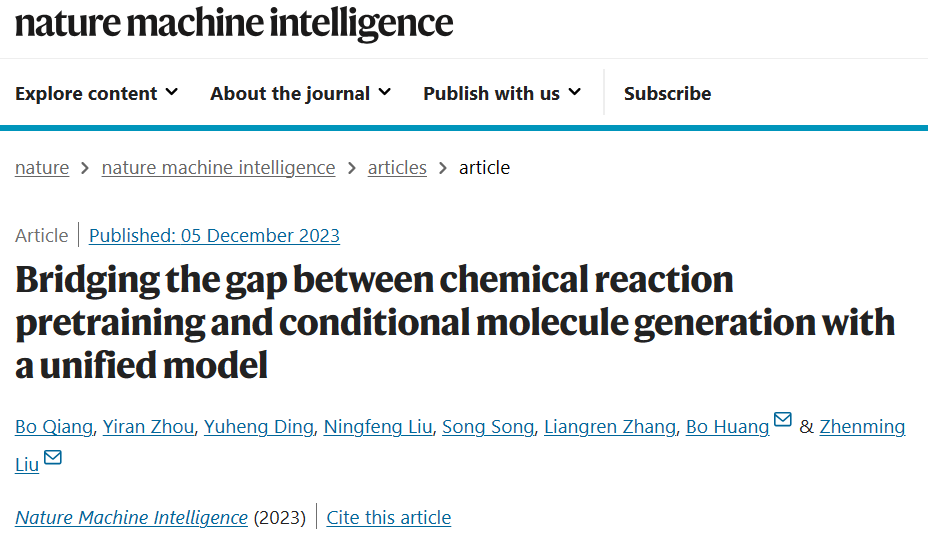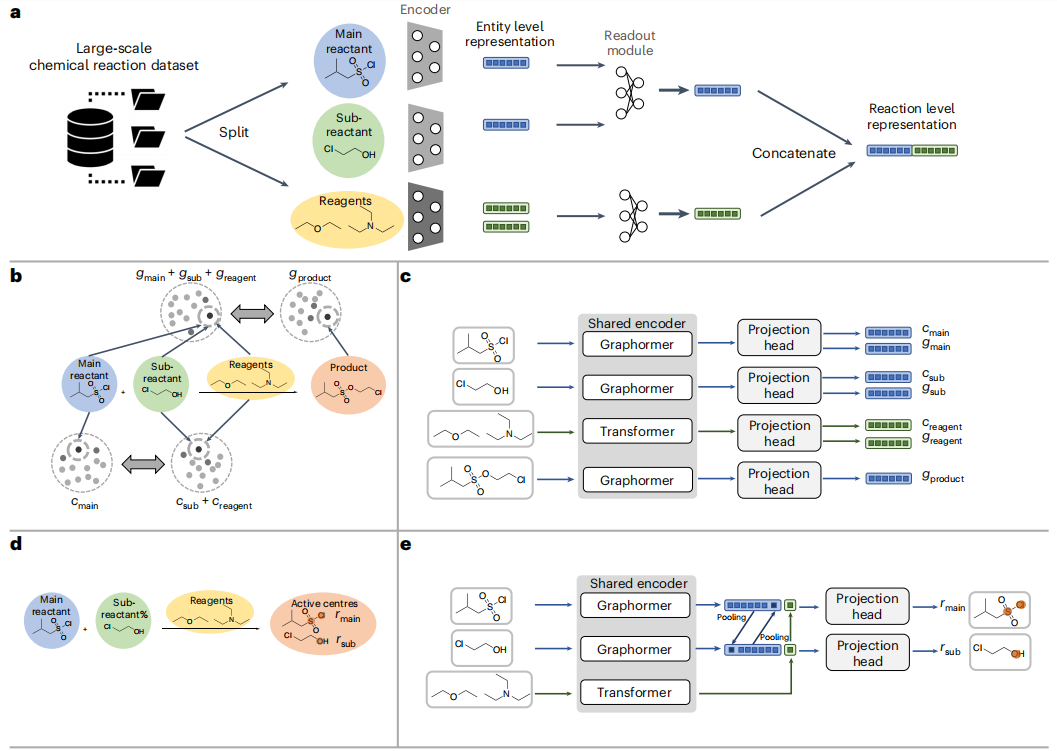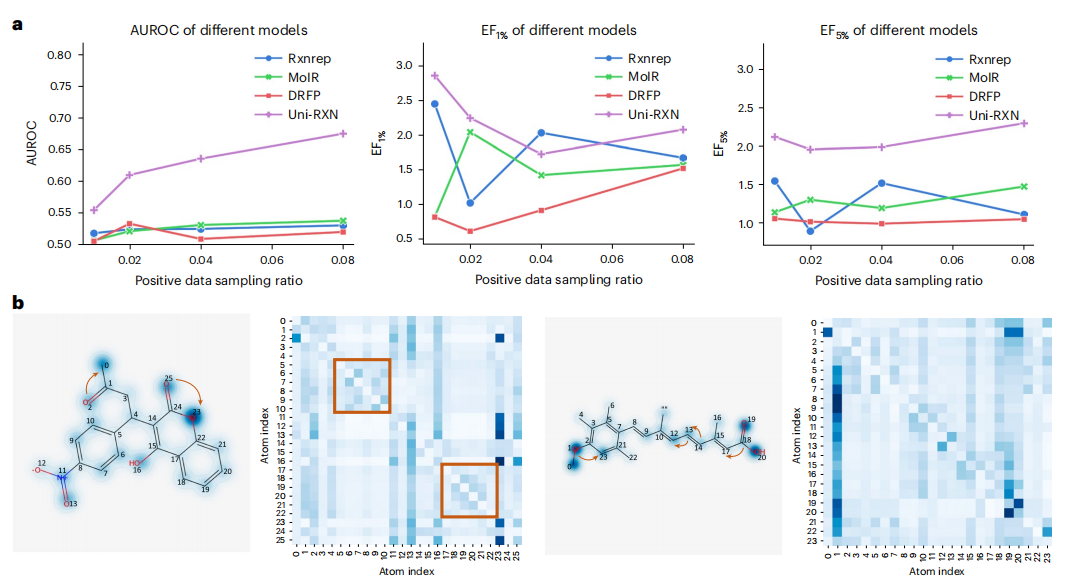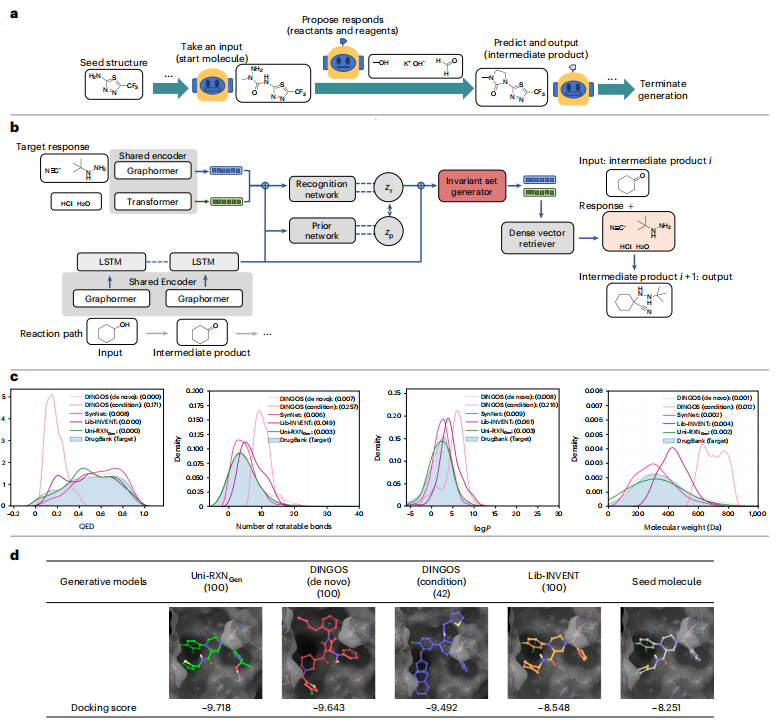 Technology peripherals
Technology peripherals
 AI
AI
 Peking University & Wangshi Intelligence proposes a new model: bridging the gap between chemical reaction pre-training and conditional molecule generation!
Peking University & Wangshi Intelligence proposes a new model: bridging the gap between chemical reaction pre-training and conditional molecule generation!
Peking University & Wangshi Intelligence proposes a new model: bridging the gap between chemical reaction pre-training and conditional molecule generation!
Chemical reactions are the basis of drug design and organic chemistry research. There is a growing need among the research community for a large-scale deep learning framework that can effectively capture the fundamental rules of chemical reactions.
Recently, a research team from Peking University and Wangshi Intelligence proposed a new method to bridge the gap between reaction-based molecular pre-training and generation tasks.
Inspired by the mechanisms of organic chemistry, researchers have developed a new pre-training framework that enables it to incorporate inductive bias into models. This proposed framework achieves state-of-the-art results when performing challenging downstream tasks. By leveraging knowledge of chemistry, the framework overcomes the limitations of current molecular generation models that rely on a small number of reaction templates. Across extensive experiments, the model generated high-quality, synthesizable drug-like structures
Overall, this research leads to large-scale deep learning for a variety of reaction-based applications The framework has taken an important step forward.
The research was titled "Bridging the gap between chemical reaction pretraining and conditional molecule generation with a unified model" and was published in "Nature Machine Intelligence" on December 5, 2023 .

Paper link: https://www.nature.com/articles/s42256-023-00764-9
Deep learning models have been widely used in many scientific research fields. The pre-training framework plays a positive role in the seamless integration of new tasks and can speed up the modeling process, especially when labeled data is limited
The basis of drug design and organic chemistry research It's a chemical reaction. Currently, the research and application of data mining have enabled deep learning models to be used in chemical reactions. Based on these data, there have been many data-driven studies that delve into representation learning of chemical reactions
Representation learning refers to automatically learning useful features from data and then using them for various Downstream tasks. Existing methods ignore basic theories of organic chemistry, limiting their performance.
Molecular generation based on chemical reactions
In addition to the reaction classification task, molecule generation based on chemical reactions is also an important application. In earlier studies, template-based stepwise molecule generation strategies were often employed
These template-based methods relied heavily on predefined building blocks and reactions, which narrowed the Accessible chemical space. A similar trend is found in the field of reaction product prediction, where template-based methods cannot be extrapolated to complex reactions; this problem can be solved by using template-free methods.
In reaction-based molecule generation tasks, template-free methods also show generalization advantages over template-based methods. However, existing template-free molecule generation methods can only generate molecules based on predefined reactant libraries. In addition to this, for the lead compound or lead optimization stage in drug design, it is more advantageous to utilize chemical reactions as editing tools to modify a given structure. The resulting chemical library will focus on a subset of chemical space that can be synthesized with fewer reaction steps.
A new, comprehensive deep learning framework for chemical reactions
Here, researchers propose a new, comprehensive deep learning framework for chemical reactions called Uni -RXN. It aims to solve two basic tasks: self-supervised representation learning and conditional generative modeling.

Show: Uni-RXN composition and method. (Quote from: paper)
Different from existing methods, the researchers proposed a set of self-supervised tasks specifically designed for chemical reactions. These tasks include reaction center prediction, primary reactant and subreactant pairing, and reactant-product pairing. In an extensive evaluation on challenging reaction tasks, the Uni-RXN method surpasses the state-of-the-art, demonstrating its ability to effectively capture domain knowledge of chemical reactions. The promising results obtained pave the way for widespread downstream applications
By effectively capturing chemical rules, Uni-RXN is well suited for generation tasks. Unlike traditional methods that rely on selecting fragments from a library of predefined reactants, Uni-RXN takes molecular structures as input conditions and generates representations of the corresponding reactants while maintaining permutation invariance within the reaction. Leveraging the power of the dense vector similarity search package, Uni-RXN enables efficient retrieval of reactants from large reactant and reagent libraries. Subsequently, a reaction prediction model is employed to generate product outputs.
Compared to template-based methods that explore only a limited subset of chemical space, Uni-RXN exhibits superior performance in generating a wider range of synthesizable drug-like structures. This feature makes it particularly suitable for virtual library enumeration, and is supported by comprehensive statistical analysis and case studies.
The Uni-RXN approach has many advantages and can generate rich representations for the challenging chemical reaction classification task. Compared with other baseline models, Uni-RXN achieves an accuracy of 58.7% with only 4 data points per category
Rewritten content: Chemical reaction classification See Table 1 for accuracy. (Source: Paper)

Transformer models can be used to differentiate between optimized and unoptimized chemical reaction data. In addition, the encoder can also be easily applied to the generation of structural conditions

The content that needs to be rewritten is: The chart shows the retrieval performance of Uni-RXN and attention weight. (Source: Paper)
The results highlight the favorable properties of molecules generated by the proposed model, which make them well suited for drug discovery tasks. The model can generate more molecules with drug-like properties and synthesizability

Illustration: Uni-RXNGen process and performance. (Source: paper)
Combined with virtual screening methods such as molecular docking, this generated model can achieve efficient structure-activity relationship research. The huge synthetic drug-like chemical space generated by this model can improve the true positive rate of drug repurposing or hit molecule searches.
The above is the detailed content of Peking University & Wangshi Intelligence proposes a new model: bridging the gap between chemical reaction pre-training and conditional molecule generation!. For more information, please follow other related articles on the PHP Chinese website!

Hot AI Tools

Undresser.AI Undress
AI-powered app for creating realistic nude photos

AI Clothes Remover
Online AI tool for removing clothes from photos.

Undress AI Tool
Undress images for free

Clothoff.io
AI clothes remover

AI Hentai Generator
Generate AI Hentai for free.

Hot Article

Hot Tools

Notepad++7.3.1
Easy-to-use and free code editor

SublimeText3 Chinese version
Chinese version, very easy to use

Zend Studio 13.0.1
Powerful PHP integrated development environment

Dreamweaver CS6
Visual web development tools

SublimeText3 Mac version
God-level code editing software (SublimeText3)

Hot Topics
 1377
1377
 52
52
 The world's most powerful open source MoE model is here, with Chinese capabilities comparable to GPT-4, and the price is only nearly one percent of GPT-4-Turbo
May 07, 2024 pm 04:13 PM
The world's most powerful open source MoE model is here, with Chinese capabilities comparable to GPT-4, and the price is only nearly one percent of GPT-4-Turbo
May 07, 2024 pm 04:13 PM
Imagine an artificial intelligence model that not only has the ability to surpass traditional computing, but also achieves more efficient performance at a lower cost. This is not science fiction, DeepSeek-V2[1], the world’s most powerful open source MoE model is here. DeepSeek-V2 is a powerful mixture of experts (MoE) language model with the characteristics of economical training and efficient inference. It consists of 236B parameters, 21B of which are used to activate each marker. Compared with DeepSeek67B, DeepSeek-V2 has stronger performance, while saving 42.5% of training costs, reducing KV cache by 93.3%, and increasing the maximum generation throughput to 5.76 times. DeepSeek is a company exploring general artificial intelligence
 AI subverts mathematical research! Fields Medal winner and Chinese-American mathematician led 11 top-ranked papers | Liked by Terence Tao
Apr 09, 2024 am 11:52 AM
AI subverts mathematical research! Fields Medal winner and Chinese-American mathematician led 11 top-ranked papers | Liked by Terence Tao
Apr 09, 2024 am 11:52 AM
AI is indeed changing mathematics. Recently, Tao Zhexuan, who has been paying close attention to this issue, forwarded the latest issue of "Bulletin of the American Mathematical Society" (Bulletin of the American Mathematical Society). Focusing on the topic "Will machines change mathematics?", many mathematicians expressed their opinions. The whole process was full of sparks, hardcore and exciting. The author has a strong lineup, including Fields Medal winner Akshay Venkatesh, Chinese mathematician Zheng Lejun, NYU computer scientist Ernest Davis and many other well-known scholars in the industry. The world of AI has changed dramatically. You know, many of these articles were submitted a year ago.
 Hello, electric Atlas! Boston Dynamics robot comes back to life, 180-degree weird moves scare Musk
Apr 18, 2024 pm 07:58 PM
Hello, electric Atlas! Boston Dynamics robot comes back to life, 180-degree weird moves scare Musk
Apr 18, 2024 pm 07:58 PM
Boston Dynamics Atlas officially enters the era of electric robots! Yesterday, the hydraulic Atlas just "tearfully" withdrew from the stage of history. Today, Boston Dynamics announced that the electric Atlas is on the job. It seems that in the field of commercial humanoid robots, Boston Dynamics is determined to compete with Tesla. After the new video was released, it had already been viewed by more than one million people in just ten hours. The old people leave and new roles appear. This is a historical necessity. There is no doubt that this year is the explosive year of humanoid robots. Netizens commented: The advancement of robots has made this year's opening ceremony look like a human, and the degree of freedom is far greater than that of humans. But is this really not a horror movie? At the beginning of the video, Atlas is lying calmly on the ground, seemingly on his back. What follows is jaw-dropping
 KAN, which replaces MLP, has been extended to convolution by open source projects
Jun 01, 2024 pm 10:03 PM
KAN, which replaces MLP, has been extended to convolution by open source projects
Jun 01, 2024 pm 10:03 PM
Earlier this month, researchers from MIT and other institutions proposed a very promising alternative to MLP - KAN. KAN outperforms MLP in terms of accuracy and interpretability. And it can outperform MLP running with a larger number of parameters with a very small number of parameters. For example, the authors stated that they used KAN to reproduce DeepMind's results with a smaller network and a higher degree of automation. Specifically, DeepMind's MLP has about 300,000 parameters, while KAN only has about 200 parameters. KAN has a strong mathematical foundation like MLP. MLP is based on the universal approximation theorem, while KAN is based on the Kolmogorov-Arnold representation theorem. As shown in the figure below, KAN has
 Google is ecstatic: JAX performance surpasses Pytorch and TensorFlow! It may become the fastest choice for GPU inference training
Apr 01, 2024 pm 07:46 PM
Google is ecstatic: JAX performance surpasses Pytorch and TensorFlow! It may become the fastest choice for GPU inference training
Apr 01, 2024 pm 07:46 PM
The performance of JAX, promoted by Google, has surpassed that of Pytorch and TensorFlow in recent benchmark tests, ranking first in 7 indicators. And the test was not done on the TPU with the best JAX performance. Although among developers, Pytorch is still more popular than Tensorflow. But in the future, perhaps more large models will be trained and run based on the JAX platform. Models Recently, the Keras team benchmarked three backends (TensorFlow, JAX, PyTorch) with the native PyTorch implementation and Keras2 with TensorFlow. First, they select a set of mainstream
 Time Series Forecasting NLP Large Model New Work: Automatically Generate Implicit Prompts for Time Series Forecasting
Mar 18, 2024 am 09:20 AM
Time Series Forecasting NLP Large Model New Work: Automatically Generate Implicit Prompts for Time Series Forecasting
Mar 18, 2024 am 09:20 AM
Today I would like to share a recent research work from the University of Connecticut that proposes a method to align time series data with large natural language processing (NLP) models on the latent space to improve the performance of time series forecasting. The key to this method is to use latent spatial hints (prompts) to enhance the accuracy of time series predictions. Paper title: S2IP-LLM: SemanticSpaceInformedPromptLearningwithLLMforTimeSeriesForecasting Download address: https://arxiv.org/pdf/2403.05798v1.pdf 1. Large problem background model
 Tesla robots work in factories, Musk: The degree of freedom of hands will reach 22 this year!
May 06, 2024 pm 04:13 PM
Tesla robots work in factories, Musk: The degree of freedom of hands will reach 22 this year!
May 06, 2024 pm 04:13 PM
The latest video of Tesla's robot Optimus is released, and it can already work in the factory. At normal speed, it sorts batteries (Tesla's 4680 batteries) like this: The official also released what it looks like at 20x speed - on a small "workstation", picking and picking and picking: This time it is released One of the highlights of the video is that Optimus completes this work in the factory, completely autonomously, without human intervention throughout the process. And from the perspective of Optimus, it can also pick up and place the crooked battery, focusing on automatic error correction: Regarding Optimus's hand, NVIDIA scientist Jim Fan gave a high evaluation: Optimus's hand is the world's five-fingered robot. One of the most dexterous. Its hands are not only tactile
 FisheyeDetNet: the first target detection algorithm based on fisheye camera
Apr 26, 2024 am 11:37 AM
FisheyeDetNet: the first target detection algorithm based on fisheye camera
Apr 26, 2024 am 11:37 AM
Target detection is a relatively mature problem in autonomous driving systems, among which pedestrian detection is one of the earliest algorithms to be deployed. Very comprehensive research has been carried out in most papers. However, distance perception using fisheye cameras for surround view is relatively less studied. Due to large radial distortion, standard bounding box representation is difficult to implement in fisheye cameras. To alleviate the above description, we explore extended bounding box, ellipse, and general polygon designs into polar/angular representations and define an instance segmentation mIOU metric to analyze these representations. The proposed model fisheyeDetNet with polygonal shape outperforms other models and simultaneously achieves 49.5% mAP on the Valeo fisheye camera dataset for autonomous driving



